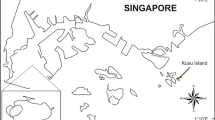Abstract.
The distribution and habitat associations of detrivorous blennies on a tropical coral reef were investigated at several spatial scales and compared with other fish that feed on the epilithic algal matrix to assess density and biomass contributions of small detrivorous fishes to these assemblages. At broad spatial scales total blenny abundance and biomass were highest on the tops of reefs exposed to prevailing winds. On the finer scale of microhabitat use, all species showed a preference for non-living corals, although the type of coral utilised differed between species. The high abundance of blennies on reef tops and non-living corals may be partially related to the quality and availability of detritus in these habitats. Comparisons of total blenny abundance and biomass with other territorial detrivores found that blennies accounted for approximately 60% of this functional group's density and 21% of their biomass on exposed reef tops. Overall, territorial detrivores were found to constitute approximately 37% of the density and 26% of the biomass of the detrivorous/herbivorous fish assemblage on exposed reef tops. Small detrivorous fish therefore represent a substantial proportion of fish assemblages that feed on epilithic algae and associated detritus on coral reefs.
Similar content being viewed by others
Author information
Authors and Affiliations
Additional information
Electronic Publication
Rights and permissions
About this article
Cite this article
Wilson, .S. Multiscale habitat associations of detrivorous blennies (Blenniidae: Salariini). Coral Reefs 20, 245–251 (2001). https://doi.org/10.1007/s003380100165
Received:
Accepted:
Issue Date:
DOI: https://doi.org/10.1007/s003380100165




